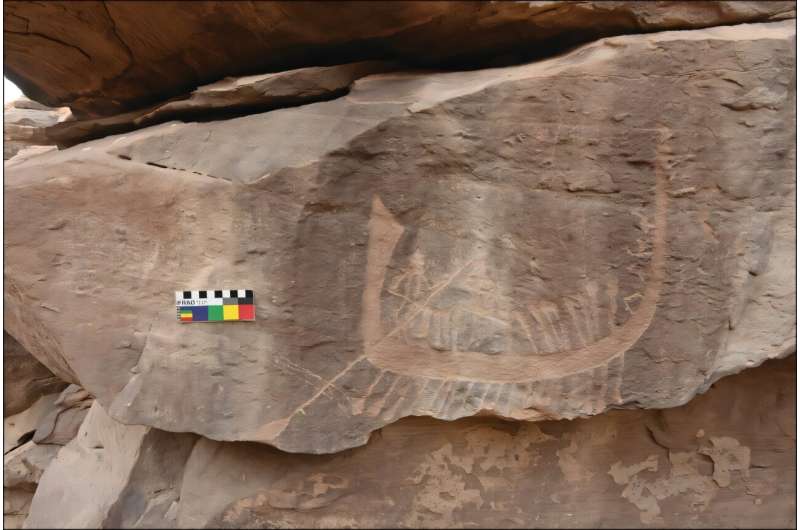Rock Art Sheds Light on the Origins of Egyptian Pharaohs

July 9, 2025
by Antiquity
edited by Lisa Lock, reviewed by Robert Egan
scientific editor
associate editor
This article has been reviewed according to Science X's editorial process and policies. Editors have highlighted the following attributes while ensuring the content's credibility:
fact-checked
peer-reviewed publication
trusted source
proofread
A rock art panel near Aswan, Egypt, may depict a rare example of an elite individual from the First Dynasty, shedding light on the formation of the ancient Egyptian state.
The late 4th millennium BC was a key period in Egyptian history which saw the beginning of political unification across Egypt, ultimately leading to the formation of the Egyptian state by the first pharaoh, Narmer, about 3100 BC.
However, little is known about how this pivotal process in prehistory took place.
'State formation in ancient Egypt and the processes that led to it are still difficult to conceptualize,' states author of the research, Dr. Dorian Vanhulle from the Musée du Malgré-Tout.
'The rock art of the Lower Nile Valley has the potential to help identify and analyze the earliest forms of political power in this region and how the landscape was exploited to express and consolidate authority. However, the number of relevant examples is limited.'
Therefore, a petroglyph panel showing what might be an early example of an Egyptian political elite individual is a fortunate occurrence.
The engraving is well-preserved and seems to portray an ornate boat being dragged by five figures. A standing figure propels the boat with an oar, while another figure remains seated on a structure that is interpreted as a palanquin.
'Boats are among the most frequently recurring motifs in Egyptian iconography,' says Dr. Vanhulle. 'During the Predynastic and Protodynastic periods (c. 4500–3085 BC), the periods which foreshadowed pharaonic Egypt, the boat is ubiquitous and invested with complex ideological and symbolic meanings.'
To determine when this panel dates to, Dr. Vanhulle compared the petroglyph to other examples of boats depicted in pre-pharaonic art and craftsmanship. His findings are published in the journal Antiquity.
Through this comparison, he was able to suggest that the rock art was made during the transition from the Protodynastic to Early Dynastic periods. This was the time during which the Egyptian state was first formed, centuries before the first pyramids.
Importantly, it appears that the panel bears strong stylistic and iconographic affinities with the official imagery produced at the end of the Protodynastic period, up to the reign of Narmer. For example, the seated figure has an elongated chin, which may represent the false beards worn by Egyptian kings since the First Dynasty.
This suggests that the seated figure was a member of the ruling class at the dawn of the First Dynasty.
Furthermore, the high quality of the image suggests it was commissioned by an early political authority in Egypt, signaling that rock art was a key method by which early Egyptian elites communicated their power.
This has significant implications for our understanding of the origins of the Egyptian state.
'The rock panel is an important addition to the existing corpus of engravings that can help us to better understand the role of rock art in the crucial events that led to the formation of the Egyptian state,' Dr. Vanhulle explains. 'Rock compositions became a tool for the authorities to communicate, mark the landscape and assert their power.'
It also indicates the importance of recording the rock art as quickly as possible.
'The landscape of the valley and its desert margins is currently being irreparably altered by, among other threats, mining and quarrying activities,' concludes Dr. Vanhulle. 'The urgency of conducting rescue missions such as the one that led to the discovery of the discussed panel cannot be underestimated.'
More information: Dorian Vanhulle et al, An early ruler etched in stone? A rock art panel from the west bank of Aswan (Egypt), Antiquity (2025). doi.org/10.15184/aqy.2025.60
Journal information: Antiquity
Provided by Antiquity




